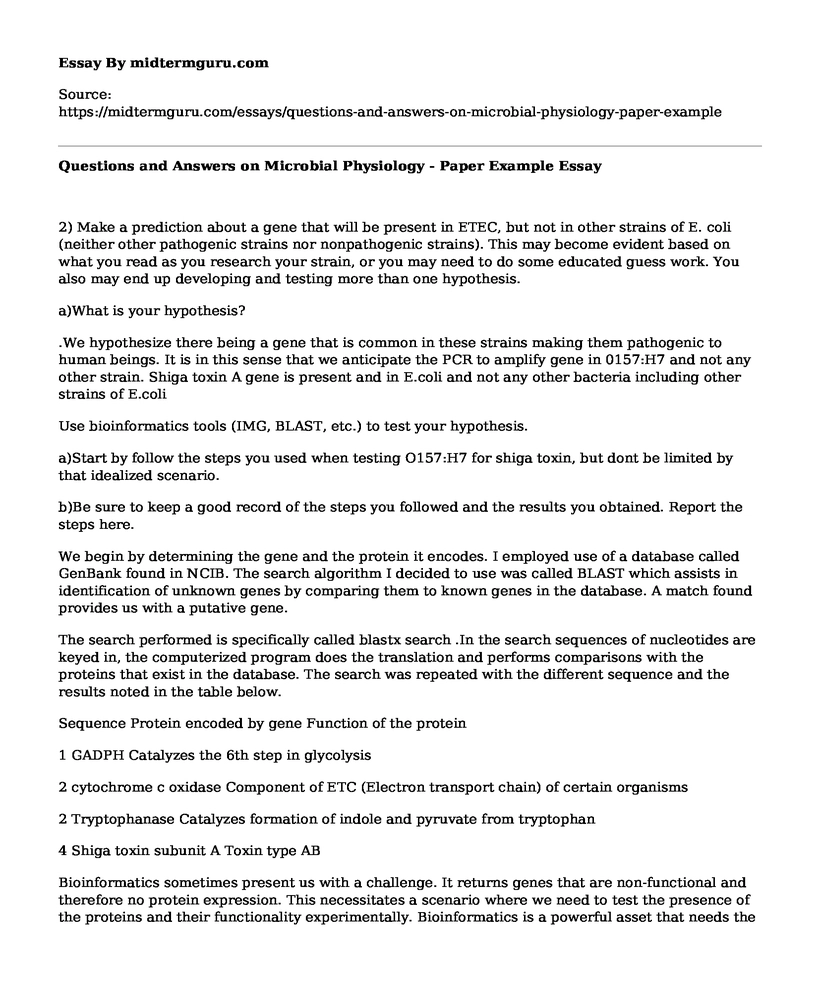2) Make a prediction about a gene that will be present in ETEC, but not in other strains of E. coli (neither other pathogenic strains nor nonpathogenic strains). This may become evident based on what you read as you research your strain, or you may need to do some educated guess work. You also may end up developing and testing more than one hypothesis.
a)What is your hypothesis?
.We hypothesize there being a gene that is common in these strains making them pathogenic to human beings. It is in this sense that we anticipate the PCR to amplify gene in 0157:H7 and not any other strain. Shiga toxin A gene is present and in E.coli and not any other bacteria including other strains of E.coli
Use bioinformatics tools (IMG, BLAST, etc.) to test your hypothesis.
a)Start by follow the steps you used when testing O157:H7 for shiga toxin, but dont be limited by that idealized scenario.
b)Be sure to keep a good record of the steps you followed and the results you obtained. Report the steps here.
We begin by determining the gene and the protein it encodes. I employed use of a database called GenBank found in NCIB. The search algorithm I decided to use was called BLAST which assists in identification of unknown genes by comparing them to known genes in the database. A match found provides us with a putative gene.
The search performed is specifically called blastx search .In the search sequences of nucleotides are keyed in, the computerized program does the translation and performs comparisons with the proteins that exist in the database. The search was repeated with the different sequence and the results noted in the table below.
Sequence Protein encoded by gene Function of the protein
1 GADPH Catalyzes the 6th step in glycolysis
2 cytochrome c oxidase Component of ETC (Electron transport chain) of certain organisms
2 Tryptophanase Catalyzes formation of indole and pyruvate from tryptophan
4 Shiga toxin subunit A Toxin type AB
Bioinformatics sometimes present us with a challenge. It returns genes that are non-functional and therefore no protein expression. This necessitates a scenario where we need to test the presence of the proteins and their functionality experimentally. Bioinformatics is a powerful asset that needs the backing of other told in order to draw a meaningful conclusion.
Basing my knowledge on the functional proteins, I developed a prediction in the table below.
Sequence Protein Species
1 GAPDH Every species
2 cytochrome c oxidase Absent in E.coli
3 Tryptophanase Present in all E.coli
4 Shiga toxin subunit Unique to E.coli O157:H7
This is what forms the basis of our hypothesis.
Hypothesis testing
To effectively test our theory, we performed a search on various bacteria to check if the gene sequence is present. This time we used IMG database hosted by JIG. The database contains all microbial sequences.
My search was on E.coli O157:H7, E.coli K12 DHI, Pseudomonas aeruginosa PA01 and Sakai. Use of keywords such as shiga toxin, Tryptophanase, glyceraldehyde and cytochrome c oxidase were instrumental in a successful search. Results from my search ere documented in the table below.
Sequence Gene product Genome(s) present Genome(s) absent
1 GAPDH O157:H7,Pseudomonas,K12 2 Cytochrome c oxidase Pseudomonas O157:H7and K12
3 Tryptophanase O157:H7, K12 Pseudomonas
4 Shiga toxin A subunit O157:H7 Pseudomonas and K12
From the result it can be noted that Shiga toxin A subunit is unique and present only in E.coli O157.This means that our hypothesis passes as true.
4) Propose actual lab experiments you would do to demonstrate the utility of the PCR assay.
a)What gene will you amplify by PCR?
O157:H7
How will you set up the PCR?
Each tube will have different template included and has to correspond to genomic DNA isolated from E.coli K 12, P.aeroginosa, and E.coli o157:H7 and water body isolated E.coli.
i)What reagents will you add?
Down and upstream primers for sequence number 4, Nucleotides, templates and polymerase (taq)
ii)What strains will you use?
E.coli K 12, P.aeroginosa, and E.coli O157:H7 and water body isolated E.coli.
iii) What controls will you include?
No-template control to ensure no contamination in the reagents and the amplification is true
iv) What cycling conditions will you use?
Cycles number of between 30-40 of 94 , 60-65 and 72
b)Diagram the results you would obtain after gel electrophoresis.
i)What size will the PCR product be?
960 bpii)What lanes should have a PCR product?
Lane 5
iii)What conclusions can be drawn?
The lake isolate is likely E.coli 0157:H7 due to its similarity with shiga toxin subunit A amplified from the template.
Cite this page
Questions and Answers on Microbial Physiology - Paper Example. (2021, Jun 08). Retrieved from https://midtermguru.com/essays/questions-and-answers-on-microbial-physiology-paper-example
If you are the original author of this essay and no longer wish to have it published on the midtermguru.com website, please click below to request its removal:
- Essay on Reproductive Techniques and Technologies: Cohen and Mcmahan
- Paper Example on Microbiology
- Smartphone Addictions are Causing Long-Term Imbalances in Our Brains: Annotated Bibliography
- Paper Example on Primate Intelligence Evolution
- Paper Example on Ecology, Evolution, and Development
- Biotech: Unlocking Biological Processes for Industrial Use - Essay Sample
- CTE: Brain Injuries, Thinking & Memory Problems, and Behavioral Changes - Research Paper







